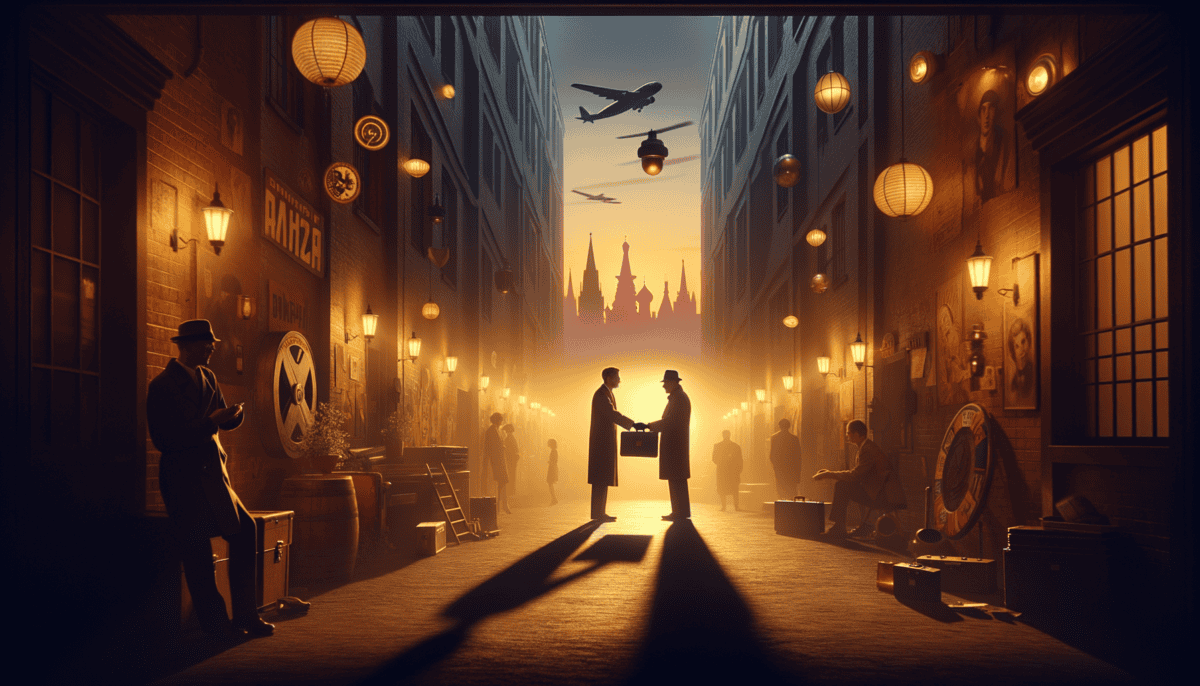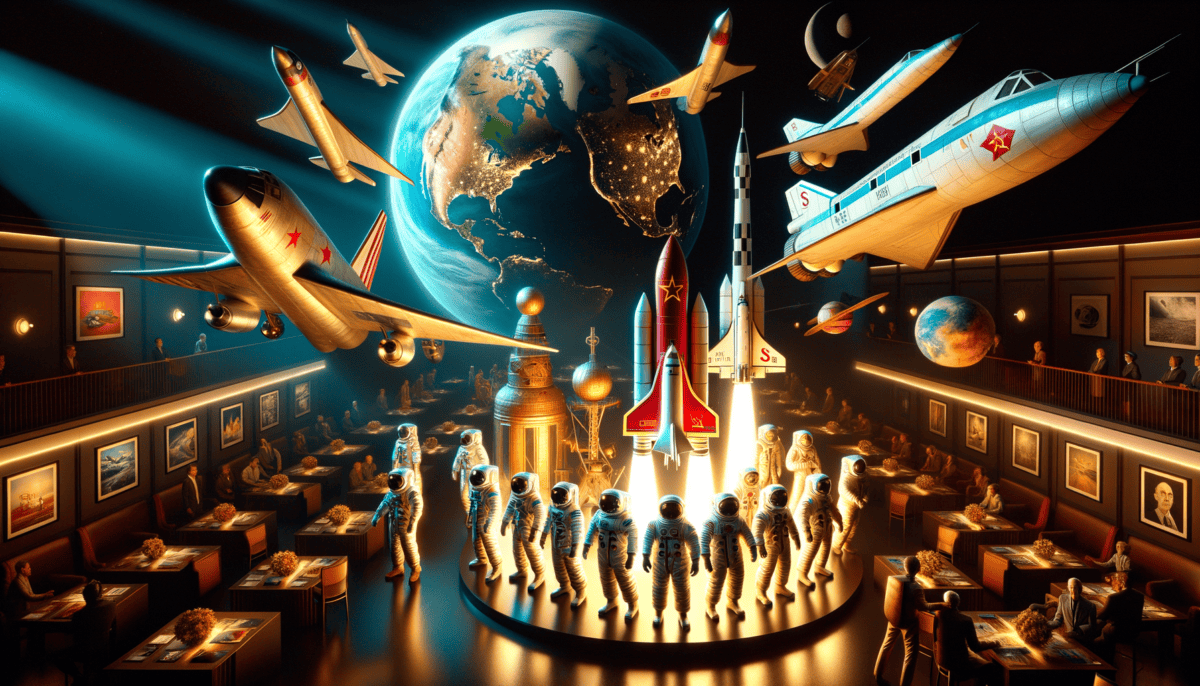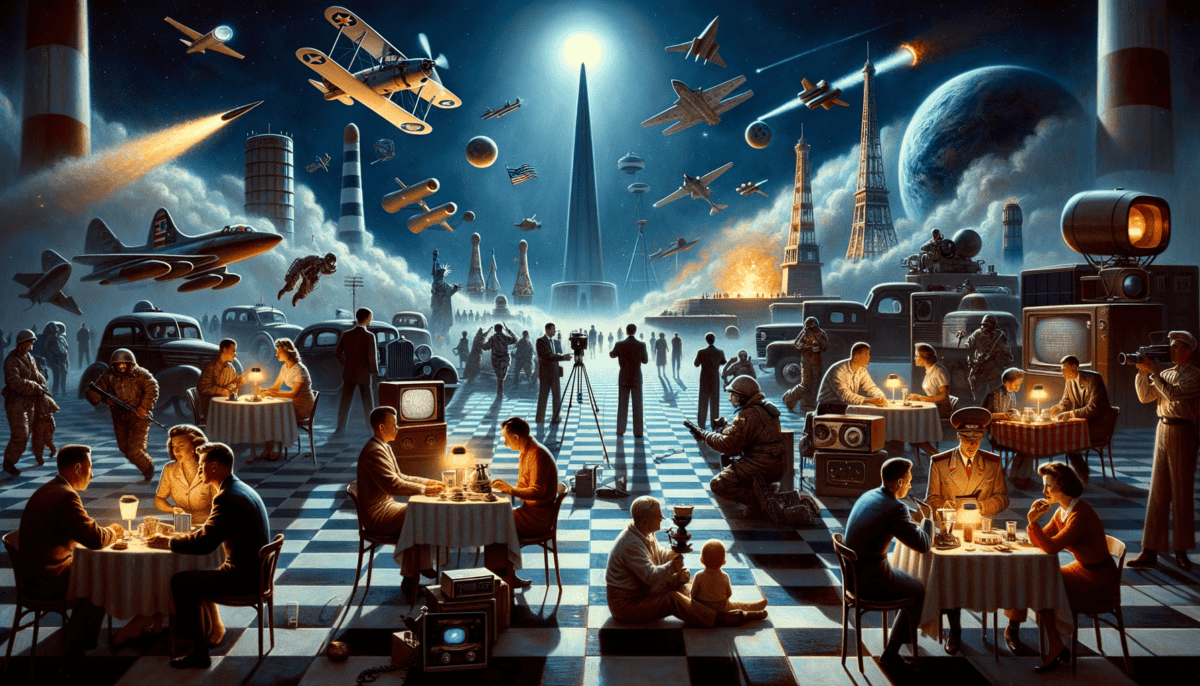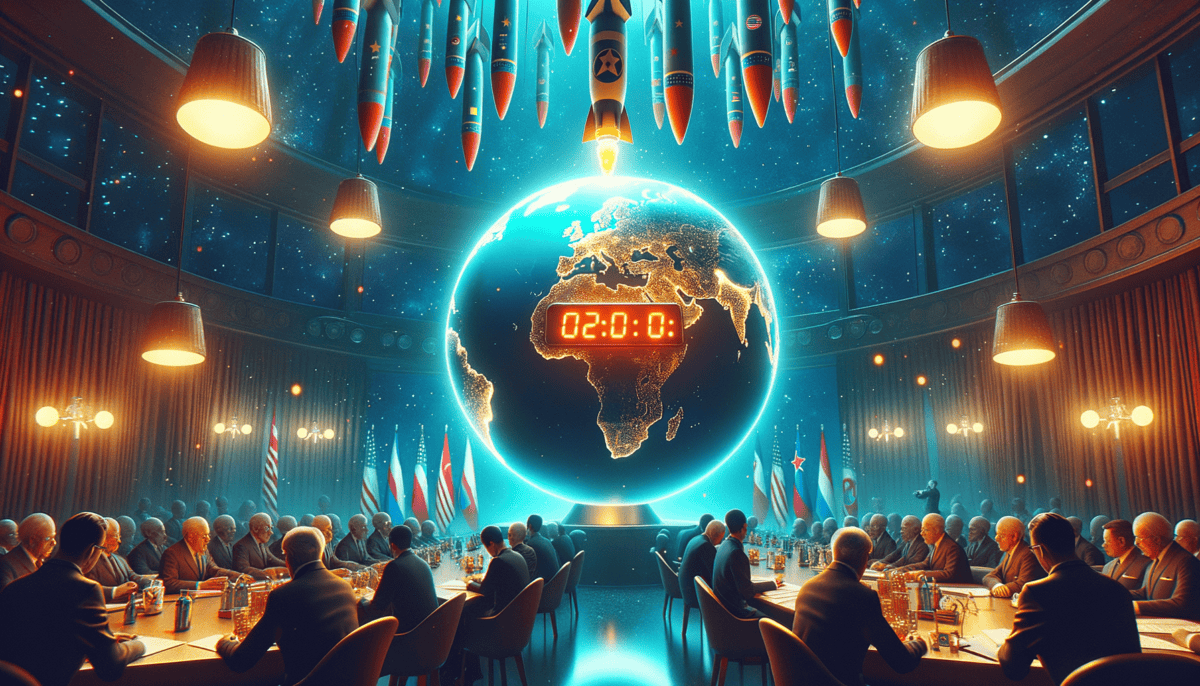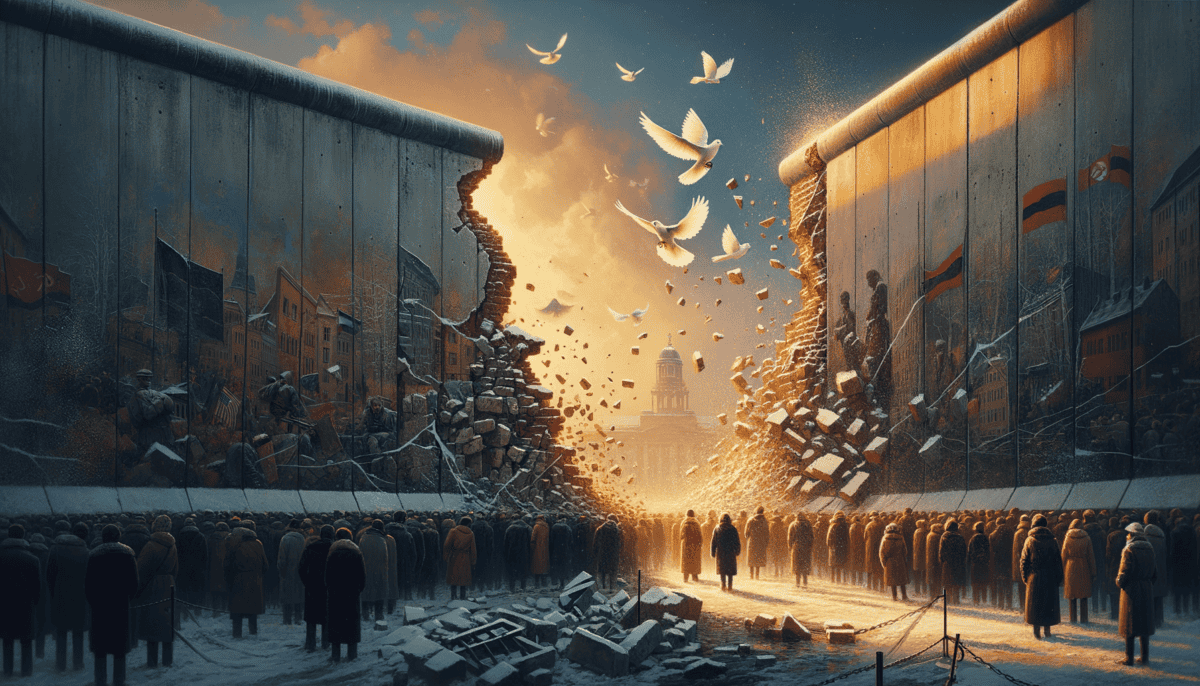A World Divided
Tommy sat at his desk, staring at the old black and white photograph his grandfather had given him. It showed two cities separated by a big wall.
"Grandpa, why did they build such a big wall?" Tommy asked, his eyes wide with curiosity.
Grandpa Jack smiled and pulled up a chair. "Well, Tommy, it all started after a big war called World War II. The world became split into two different sides, just like when you and your friend Billy couldn't agree on which game to play at recess."
Tommy nodded. He remembered that day well.
"On one side was America and its friends. We believed people should be free to choose how to live their lives. On the other side was a country called the Soviet Union. They had different ideas about how people should live."
Fun Fact: The wall in the picture was called the Berlin Wall. It split one city into two parts for 28 years!
"But why couldn't they just be friends?" Tommy asked.
Grandpa Jack took out a world map. "See these colors? The blue parts show America's friends, and the red parts show Soviet friends. It was like having two big teams at school, and everyone had to pick a side."
"Like choosing teams for kickball?" Tommy asked.
"Exactly! But this was much bigger. Both sides were scared of each other. They built lots of weapons and tried to get other countries to join their team."
Tommy looked worried. "That sounds scary, Grandpa."
"It was scary sometimes. But you know what's amazing? Nobody actually fought each other directly. Instead, they had competitions."
Grandpa pulled out another picture, this time of a rocket launching into space. Tommy's eyes lit up.
"Wow! Real rockets?"
"Yes! Both sides worked super hard to build better rockets and send people to space. It was like a big race to see who could do it first."
The Iron Curtain
"But what about the wall, Grandpa?" Tommy remembered his first question.
"Ah yes. A man named Winston Churchill said an 'Iron Curtain' had fallen across Europe. It wasn't a real curtain – it was invisible. But it separated the two sides just like the curtain in your school's auditorium separates the stage from the seats."
Tommy tried to imagine a giant curtain across the whole world. It made him giggle.
"The wall in Berlin became a symbol of this division. People on one side couldn't visit their friends and family on the other side."
Tommy looked at the photograph again. He noticed something new – people standing on both sides of the wall, looking at each other but unable to meet.
"That must have made them very sad," Tommy said quietly.
"It did. But remember, Tommy, even though the world was divided, people never stopped hoping for peace. They kept trying to find ways to talk to each other and understand each other better."
️
Tommy smiled. He understood now why his grandfather wanted to share these stories with him. Even when things seem really difficult, there's always hope for making things better.
"What happened next, Grandpa?" Tommy asked eagerly, ready to hear more about this fascinating time in history.
Grandpa Jack's eyes twinkled. "Well, that's when things got really interesting. Both sides started sending spies to learn each other's secrets…"
Secrets in the Shadows
“Spies?” Tommy leaned forward in his chair, his eyes growing wide. “Like James Bond?”
Grandpa Jack chuckled. “Kind of! But real spies didn’t have fancy cars with rockets or laser watches. They had to be very sneaky and clever.”
️
“The Americans had a group called the CIA, and the Soviets had the KGB. These were like two big teams of secret helpers.”
Tommy’s face scrunched up. “But what did they do?”
“Well,” Grandpa said, pulling out another old photo, “they tried to find out what the other side was planning. Sometimes they used special mailboxes called ‘dead drops’ to share secret messages.”
Spy Fact: Spies used invisible ink to write secret messages that could only be seen with special light!
The Berlin Tunnel
“Let me tell you about one of the coolest spy missions,” Grandpa said. “The Americans dug a super-secret tunnel under Berlin to listen to Soviet phone calls!”
“Like when I use cups and string to talk to my friend next door?” Tommy asked excitedly.
“Exactly like that, but much bigger! The tunnel was as long as 100 school buses lined up together.”
The Bridge of Spies
“Sometimes,” Grandpa continued, “spies from both sides got caught. When that happened, they had a special bridge where they would trade spies back to their home countries.”
“Like trading baseball cards?” Tommy asked.
“Sort of! One famous trade happened on a foggy morning in 1962. An American spy named Powers was traded for a Soviet spy named Abel. They walked across the bridge in opposite directions, right past each other!”
Secret Gadgets
“The spies had lots of cool tools,” Grandpa explained, showing Tommy some pictures. “Look at this – a camera hidden inside a coat button!”
Tommy’s eyes sparkled. “Did they have other cool stuff?”
“They sure did! They had:
- Hollow coins to hide messages
- Shoes with secret compartments
- Pens that could take pictures
- Maps printed on silk that wouldn’t make noise
- Special radios smaller than a lunch box
The Cat Spy
“Want to hear something really silly?” Grandpa asked. “The CIA once tried to turn a cat into a spy!”
Tommy giggled. “A cat?”
“Yes! They thought they could put tiny microphones in the cat and have it walk near people to listen to their conversations. But on its first mission, the cat got distracted by a bird and ran away!”
“The most important thing about these spies,” Grandpa said seriously, “was that they helped prevent big fights between countries. By knowing what the other side was doing, both teams could avoid surprises.”
“Like when I tell Billy I’m going to tag him at recess, so he knows to run?” Tommy asked.
“That’s right! Knowledge helped keep everyone safer.”
Tommy looked thoughtful. “What else happened during the Cold War, Grandpa?”
Grandpa smiled. “Well, remember those rockets I mentioned? Both sides decided to have a big race – not on the ground, but in space!”
Race to the Stars
“Space?” Tommy bounced in his seat. “Like astronauts and rockets?”
Grandpa Jack nodded, pulling out a yellowed newspaper. The headline read: “SPUTNIK CIRCLES EARTH!”
The First Beeps from Space
“What did it do?” Tommy asked.
“It went ‘beep… beep… beep’ as it flew over our heads,” Grandpa said, making the sound. “People would stand in their yards at night, watching this tiny dot move across the sky.”
Fun Fact: Sputnik was about the size of a beach ball and weighed less than your dog!
Dogs and Monkeys in Space
“Before sending people to space, they sent animals,” Grandpa explained. “The Soviets sent a dog named Laika.”
“A space dog?” Tommy’s eyes grew wide.
“Yes! And America sent monkeys. One was named Ham. He even learned to pull levers and push buttons in his spaceship!”
The First People in Space
“Then came the really exciting part,” Grandpa continued. “The Soviets sent the first person into space – Yuri Gagarin. He flew around Earth in just 108 minutes!”
“That’s faster than my soccer game!” Tommy exclaimed.
“America quickly followed with Alan Shepard. He went up in a rocket called Freedom 7. But instead of going all the way around Earth, he went up and came right back down – like throwing a ball in the air.”
The Moon Promise
Grandpa’s eyes twinkled. “Then President Kennedy made a big promise. He said America would send people to the moon!”
“The moon? But it’s so far away!”
“That’s right! Here are some of the amazing things they had to invent to get there:
- Special suits to keep astronauts alive in space
- Computers smaller than a house
- Food that wouldn’t float away
- Rockets taller than skyscrapers
- Cameras that could work in extreme cold and heat
Space Heroes
“Did they ever crash?” Tommy asked nervously.
“Sometimes things went wrong,” Grandpa said gently. “But the astronauts and cosmonauts were very brave. They knew exploring space was important for everyone on Earth.”
“While all this was happening in space,” Grandpa said, reaching for another photo, “there were also some big problems happening back on Earth.”
Tommy leaned closer. “What kind of problems?”
Grandpa’s face grew serious. “Well, you see, both sides started getting involved in fights in other countries…”
Wars Far From Home
“Like in Korea?” Tommy asked, pointing to a map on Grandpa’s wall.
“Exactly,” Grandpa nodded, tracing his finger across the map. “Korea was split into two parts – North and South. It was like having a line drawn right through your backyard.”
The Korean Story
“But why didn’t they just fight each other?” Tommy wondered.
Grandpa smiled gently. “That’s a good question. Both sides had such powerful weapons that a direct fight could hurt the whole world. So they played a tricky game – like chess, but with real countries.”
The Jungle War
“Vietnam was another place where this happened,” Grandpa continued, moving his finger to a different part of Asia. “It was hot and full of thick jungle.”
Important: American soldiers had to deal with rain, mud, and dense forests while fighting in Vietnam.
“Was it scary?” Tommy whispered.
“Very scary,” Grandpa replied softly. “Many brave soldiers from both sides fought there. Some were not much older than your big brother.”
The Mountain Battle
️
“Like when Billy helps me against the big kids at school?” Tommy asked.
Grandpa chuckled. “Something like that. But much more serious.”
The People Behind the Wars
Pulling out an old photo album, Grandpa showed Tommy pictures of soldiers, villages, and children from these faraway places.
“The sad thing is,” Grandpa said, “regular people like these got caught in the middle. Farmers, teachers, families – they just wanted to live their lives in peace.”
- Doctors who helped sick and hurt people
- Teachers who kept schools open
- Helpers who brought food and medicine
- Peace workers who tried to stop the fighting
- Regular people who shared what they had
Talking Instead of Fighting
“Did it help?” Tommy asked hopefully.
“Sometimes it did,” Grandpa replied. “But sometimes things got even scarier. There was one time when everyone thought the whole world might be in danger…”
Tommy’s eyes widened. “What happened then?”
Grandpa reached for an old magazine with a picture of missiles on the cover. “Well, that’s when we had what they called the Cuban Missile Crisis…”
Thirteen Days of Fear
“Missiles?” Tommy’s eyes grew wide as he looked at the old magazine cover. “Like rockets?”
Grandpa nodded gravely. “Yes, but these weren’t like the space rockets we talked about. These were very dangerous missiles. And in October 1962, they almost changed the world forever.”
The Island Discovery
️
“Were people scared?” Tommy whispered.
“Very scared,” Grandpa replied softly. “President Kennedy had to make some big decisions fast.”
The Navy Ring
Grandpa drew a circle on a piece of paper. “The president ordered navy ships to make a big circle around Cuba. No Soviet ships carrying missiles could get through.”
Fact: For 13 days, the whole world held its breath, wondering what would happen next.
“It was like a giant game of chicken,” Grandpa explained, “but with the whole world at stake.”
Hidden Heroes
️
Tommy leaned forward. “What did they do?”
“They used something very simple but very important – they talked to each other. President Kennedy and Soviet leader Khrushchev wrote letters back and forth.”
The Big Choice
Grandpa pulled out another picture showing worried-looking men in suits around a table.
- Attack the missile sites
- Start a war with the Soviets
- Send soldiers to Cuba
- Keep talking and find peace
- Make a deal that helped both sides
A Close Call
“So they found a way to fix it?” Tommy asked hopefully.
“Yes, they did,” Grandpa smiled. “But it was very close. After that, both sides realized they needed to be more careful. They made a special phone line between Washington and Moscow, just so leaders could talk directly if there was trouble.”
Learning from Fear
“The Cuban Missile Crisis taught everyone an important lesson,” Grandpa said, closing the magazine. “Sometimes being brave means knowing when to stop and talk, instead of fighting.”
Tommy thought for a moment. “Like when me and Billy fight, and Mom makes us sit down and talk it out?”
Grandpa laughed. “Exactly like that! But you know what happened next? Something amazing started happening in Europe…”
A World United Again
Tommy sat cross-legged on the floor, surrounded by his grandpa’s old photos. “What happened in Europe, Grandpa?”
“Something that changed everything,” Grandpa smiled, pulling out a chunk of concrete covered in colorful paint. “This is a piece of the Berlin Wall.”
The Wall That Split a City
“Did they knock it down?” Tommy asked, touching the painted concrete.
“They sure did! People came with hammers and picks. They climbed on top of the wall and danced. Some even used their bare hands to pull pieces off.”
The End of the Cold War
“When the wall fell, it was like the whole world took a big, happy breath. The Cold War was finally ending.”
Tommy looked confused. “But if nobody was fighting, why was it called a war?”
“Because sometimes the scariest battles are the ones we fight with our minds and hearts, not our fists,” Grandpa explained gently.
A New Beginning
- People could visit their families again
- Countries started working together
- Kids could make friends across borders
- The world felt safer and happier
- New ideas could travel freely
Lessons for Today
“The Cold War taught us many things,” Grandpa said, putting an arm around Tommy. “It showed us that talking is better than fighting. That working together is better than being apart.”
“Like when we build my LEGO sets together?” Tommy asked.
“Exactly! When people work together, amazing things can happen. We went from nearly destroying each other to exploring space together.”
Looking Forward
Tommy picked up the piece of wall again. “Can I take this to show-and-tell?”
“Of course! And remember to tell your friends the most important part – that even when things seem dark and scary, there’s always hope. People can always choose to work together and make things better.”
As the sun set outside, Tommy carefully wrapped the wall piece in tissue paper. “Thanks for telling me about the Cold War, Grandpa. I’m glad we don’t have to be scared anymore.”
Grandpa hugged him tight. “Me too, Tommy. Me too. And now it’s up to your generation to keep building bridges instead of walls.”


